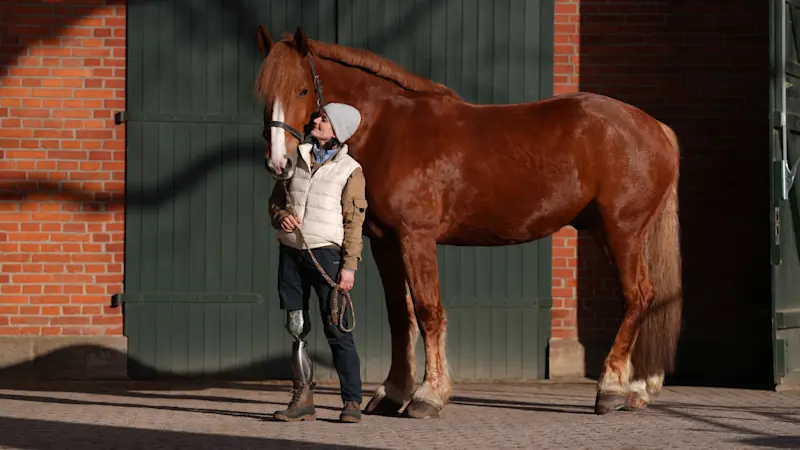40,000 steps every day with a leg prosthesis: Police horse manager Siglind is always on the go
After a leg amputation, Siglind is back to her dream job. Her special high-tech prosthesis is always with her for the demanding day-to-day work at the mounted police unit.

Tuesday, 17 September 2024
Siglind K.(46) led an active life, working as a passionate horse manager and training to become an amateur jockey until she lost her right leg starting at the knee joint in an accident at the age of 21 – and thus (at the time) her life dream as well.
From then on, a former racehorse with a hoof bone fracture provided meaning to her life and motivated her to carry on. “The horse was my therapist,” says Siglind today.
Emigrating to continue working with horses: The horse and sports enthusiast moved to South Africa to work as a therapeutic riding instructor for people with disabilities, where she became para rower at the Paralympic level.
Return to the dream job: Siglind returned to Germany in 2008. When the classification of rowing in the German national team changed, she had to rethink. In 2010, she was accepted as a horse manager after an unsolicited application by the police equestrian unit in Hanover.
No extra treatment: colleagues’ initial skepticism quickly subsides. It is of particular importance to Siglind to be treated just like everyone else and like a non-disabled person.
Every day up on her feet, shift work, outside in wind and rain: Siglind is able to cope with her physically demanding everyday work thanks to her waterproof, microprocessor-controlled prosthetic knee joint from the Genium line.
After the amputation: “My horse was my therapist”
Since her childhood, Siglind (46) has loved horses and knew that she wanted to work with the animals later on. When she completed her professional training as a horse manager, she found her dream job. Her next goal: an amateur jockey license. But she lost her right leg due to an accident in 2000 caused by third parties, which completely changed her life. “Then the dream was over, not only of becoming a jockey, but also of being a horse manager,” recalls Siglind.
Already in the hospital, she started training with dumbbells. “My goal was to get out of here very quickly and walk properly again. And that was a step by step process.” She also showed her residual limb directly in the open. “So that I also understand and accept That’s how it is now,” she says. “The accident naturally changed me. I don’t take some things so seriously anymore and value the little things in life. Everything is more intense.”
Nevertheless, the recovery was a challenge for Siglind. For the first time, she falls into a mental hole. When she left rehabilitation, her boyfriend at the time gave her a former racehorse that could no longer walk due to a hoof bone fracture. “That was my therapist. I had to go there every day, take care of it, sometimes on crutches. At first I thought, what am I supposed to do with it? I can't ride anymore anyway. But then it turned out that it can be done after all.”
Siglind’s interim stops: Therapeutic riding in South Africa and rowing at the Paralympic level
At the time, working as a horse manager with an amputated knee joint was unthinkable in Germany. But Siglind did not give up: She quickly realised that her alternative professional training as an office communication assistant was not the right thing for her. Through her friends, she learned that in South Africa it is possible to work with horses even with an amputation and a prosthesis. She emigrated there in 2005. She distributed flyers and showed what she could do at tournaments – until she finally started offering therapeutic riding on a farm to physically disabled children and adults. “I just chanced upon it. But I had a knack for this type of work, so they let me do it,” says Siglind. “My work has given me a lot in return. You could see people sitting in wheelchairs and then straightening their bodies upright again on the horse. They became one with the horse, communicated in a very different way and that was really nice to see.”
In South Africa, Siglind discovered another passion: rowing. She was a natural talent and joined the South African national para-rowing team. To compete at the 2008 Paralympic Games in Beijing, she would have had to become a South African national. A step she was not prepared to take – and so Siglind returned to Germany to join the national team there. Together with Harald Wimmer, she competed at the Paralympic Games in Beijing 2008 in para-rowing mixed doubles (class TA) and made it to the final. When the classification changed and only bilateral amputees were allowed to row in her class, the sports enthusiast had to rethink again.
Back to work as a horse manager
In her hometown, Siglind randomly noticed the equestrian police passing under her window. A decisive moment. “It kind of made a click: they also need horse managers … and I just sent in an application.” Her initiative paid off: In January 2010, she began working for the equestrian Police Unit in Hanover.
At first, she faced a mixture of scepticism and interest, precisely because the job is physically demanding: shift work, plenty of walking, pushing, carrying, pulling – and horses weigh quite a lot. But the scepticism quickly subsided, and Siglind proved that she was in no way inferior to her colleagues, despite the prosthesis. It’s important to her not to receive any special treatment due to her amputation and to work just like a non-disabled person, even though her boss keeps an eye on making sure she doesn’t necessarily climb a ladder. As she works, Siglind wears her Ottobock high-tech prosthesis from 4 a.m. to 8 p.m. 16 hours. The initial scepticism quickly subsided. Today, the other employees inquire about “Stumpi”, which is how Siglind’s residual limb was dubbed, when, for example, a blister has formed due to the summer heat and puts strain on walking.
Siglind does everything she can to stay physically fit and regularly goes to the gym so that she can ideally remain in her dream job until she retires. “I’ve found a niche for myself: This equestrian team is in the middle of the city. We have short distances, everything is central. I still walk 40,000 steps a day, of course, but that wouldn’t be possible with longer commuting times. Everything is tailored to my disability.”
Thanks to a high-tech prosthesis: How Siglind masters her daily work more easily
Siglind’s enabler is the leg prosthesis with the microprocessor-controlled knee from the Genium range. For years, she worked hard to for treatment with the smart leg prosthesis that helps her cope with her daily work more effectively: “Everything is easier. Standing is already comfortable because the strain on the back is reduced, since you don’t just stand on your sound leg. I don’t have to lift my hips as much when walking. As a result, I have less pain and tension in my neck, back, shoulders and buttocks. And it’s easier to climb stairs as well.” Siglind finds the new Genium X4 more energy-efficient than her previous prosthesis: Her leg is slightly bent instead of constantly in extension – which reduces malpositions and secondary damage. “I’m not so tired in the evening anymore. It relieves my joints and my whole body more.”
Another new feature of the Genium X4: Although the knee joint is controlled using microprocessor technology, it is fully waterproof. For the first time in 23 years, Siglind dares to go into the sea with her feet.
Further benefits include the start-to-walk function, which allows the first step to be initiated with the prosthesis side as well, making dynamic backward movement and negotiating uneven ground and slopes easier. These are all functions that make Siglind’s movements through everyday work much easier.
“The Genium X4 comes backed up by 25 years of innovation and experience in microprocessor-controlled leg prostheses. We want people with one or both amputated legs to be able to rely on their prosthesis during every movement in everyday life and beyond and to receive the best possible support. This is the only way we will achieve a higher degree of participation and inclusion – and give people like Siglind the opportunity to work like anyone else and build a life on their own terms,” explains David Wucherpfennig, market manager for prosthetics at Ottobock.
Needed: More sports opportunities for people with disabilities
For the future, Siglind would like to see more sports opportunities for people with amputations. “The general perception has changed a bit since the London 2012 Paralympic Games. But sport can help so many people. It boosts you, especially when you're restricted. More courses to try out would be nice. I think that’s very important,” she explains. And testing a sports prosthesis is right at the top of Siglind’s wish list. Just putting a prosthesis and trainers on and going jogging is her dream that has not (yet) come true, also for cost reasons.

